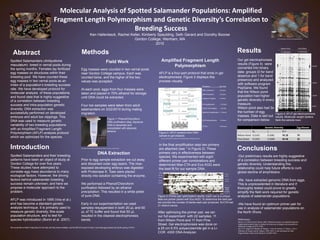
Research Poster Design
- 1. Molecular Analysis of Spotted Salamander Populations: Amplified Fragment Length Polymorphism and Genetic Diversity’s Correlation to Breeding Success Ken Hallenbeck, Rachel Keller, Kimberly Spaulding, Seth Gerard and Dorothy Boorse http://www.cortland.edu/herp/keys/images/salamand/amacullg.jpg Gordon College, Wenham, MA http://www.pbase.com/tmurray74/image/96446643 2010 Results Wilson Pond Pine Street Abstract Methods 11 individuals 11 individuals Spotted Salamanders (Ambystoma Field Work Amplified Fragment Length Our gel electrophoresis maculatum) breed in vernal pools during results (Figure 4) were Polymorphism converted into binary - 200 BP the spring months. Females lay fertilized Egg masses were counted in two vernal pools egg masses on structures within their near Gordon College campus. Each was AFLP is a four-part protocol that ends in gel data groups (0 for band breeding pool. We have counted these counted twice, and the higher of the two electrophoresis. Figure 2 displays this absence and 1 for band egg masses in two vernal pools as an values was accepted. process visually. presence) and analyzed - 145 BP index of a population’s breeding success with software program Procedure Lab Time rate. We have developed protocol for At each pool, eggs from four masses were PopGene. We found DNA Extraction ~2 hours molecular analysis of these populations, taken and placed in 70% ethanol for storage that the Wilson pond DNA Restriction ~2 hours and found data that is highly suggestive until DNA could be extracted. population had higher - 100 BP Fragment Ligation ~2 hours of a correlation between breeding genetic diversity in every success and intra-population genetic Four toe samples were taken from adult Pre-amplification ~ 2 hours measure. - 50 BP diversity. DNA extraction was salamanders on 3/22/2010 during mating Primer Pair Addition ~ 30 min Wilson pond also had 3x successfully performed on developed migration. Selective Amplification ~ 3 hours the number of egg Figure 4: AFLP gel electrophoresis embryos and adult toe clippings. This masses. Data is laid out results. Molecular weight ladders Figure 1: Phenol/Chloroform for comparison below: flank the sample rows. DNA was used to measure genetic DNA purification step. Aqueous Gel Electrophoresis ~4 hours variability of two breeding populations DNA is decanted and TOTAL: ~16 hours precipitated with absolute Genetic Diversity Egg Masses with an Amplified Fragment Length ethanol. Ho Is %P Polymorphism (AFLP) analysis protocol Figure 2: AFLP protocol from DNA sample to gel analysis Wilson Pond 0.2141 0.3381 76.18 73 which we optimized for the species. http://www.philsciletters.org/May%202,%202009/Genetic%20fingerprinting.htm Pine Street 0.1341 0.2048 40.48 23 In the final amplification step two primers Introduction http://openwetware.org/wiki/Image:DNA_extraction_w_phenol_chloroform.jpg are attached (see * in Figure 2). These Conclusions Spotted Salamanders and their breeding DNA Extraction primers vary in effectiveness between species. We experimented with eight -Our preliminary results are highly suggestive patterns have been an object of study at Prior to egg sample extraction we cut away different primer pair combinations and of a correlation between breeding success and Gordon College for over five years. and discarded outer egg layers. The now- determined Mse-CTA and Eco-AGG were genetic diversity. Understanding this These studies have attempted to exposed developing embryo was digested the best fit for our sample DNA. relationship could help future efforts to curb correlate egg mass abundance to many with Proteinase K. Toes were placed Ladder - global decline of amphibians. - M-CTT ecological factors. However, the driving directly into solution containing the enzyme. M-CTG - M-CAT - -M-CTC factors behind salamander breeding M-CAG - - M-CTA - M-CAC -We have extracted genomic DNA from eggs. success remain unknown, and here we We performed a Phenol/Chloroform M-CAA - This is unprecedented in literature and if propose a molecular approach to the purification followed by an ethanol Maize DNA thoroughly tested could prove to greatly problem. precipitation. This resulted in a white pellet Control simplify the field work required for genetic of pure DNA. Figure 3: Primer pair optimization results. Each row is a unique analysis of salamander populations. AFLP was introduced in 1995 (Vos et al.) Mse-xxx primer paired with Eco-AGG. To determine the best pair we counted the number of bands each pair produced. M-CTA had and has become a standard genetic Early in our experimentation we used 21 distinct bands. -We have found an optimum primer pair for analysis technique. It is primarily used to samples resuspended in both 20 µL and 50 use in analysis of salamander populations on measure genetic diversity, fine-scale µL of TE buffer and found that 50 µL After optimizing the primer pair, we ran the North Shore. population structure, and to test for resulted in the clearest electrophoresis our full experiment with 22 samples, 11 species hybridization (Bonin et al. 2007). bands. from Wilson Pond and 11 from Pine References: Bonin, A. D. Ehrich and S. Manel. 2007. Statistical analysis of amplified fragment Street. Gel electrophoresis was done on length polymorphism data: a toolbox for molecular ecologists and evolutionists. Molecular Ecology 16:3737-3758. We would like to thank Craig Story for his help with lab protocol details, and the BIO310 class for help in counting egg masses during the spring of 2010. a 25 cm 6.5% polyacrylamide gel in a Li- Vos, P., R. Hogers, M. Bleeker, M. Reijans, T. Lee, M. Hornes, A. Frijters, J. Pot, J. Peleman, M. Kuiper and M. Zabeau. 1995. AFLP: A new technique for DNA COR 4300 DNA Analyzer. fingerprinting. Nuleic Acids Research 23:4407-4414